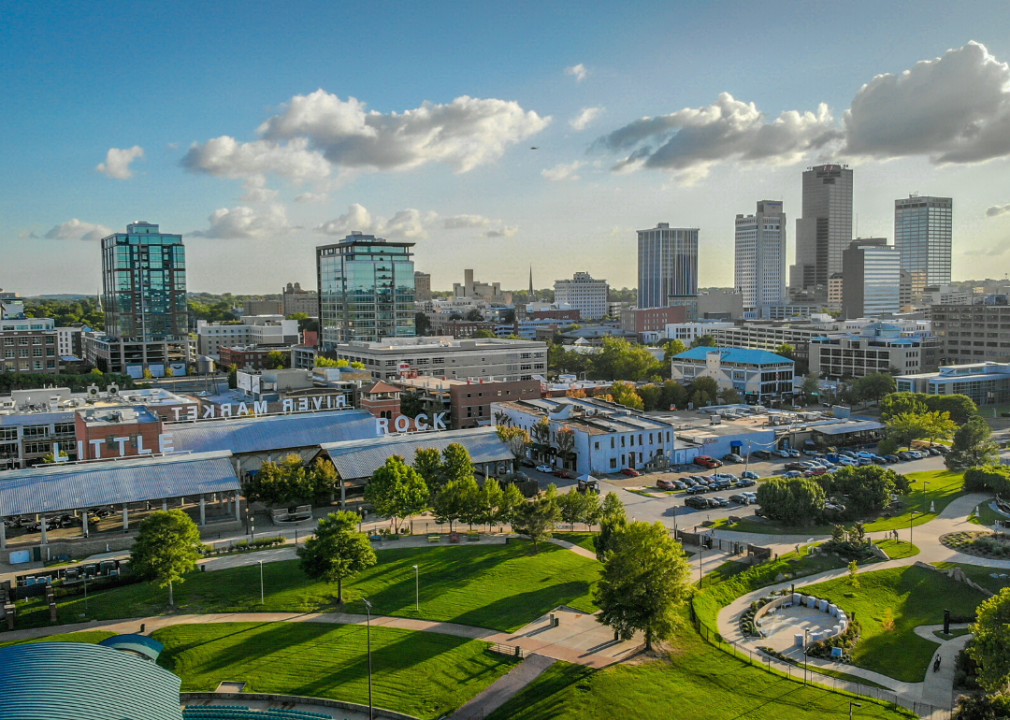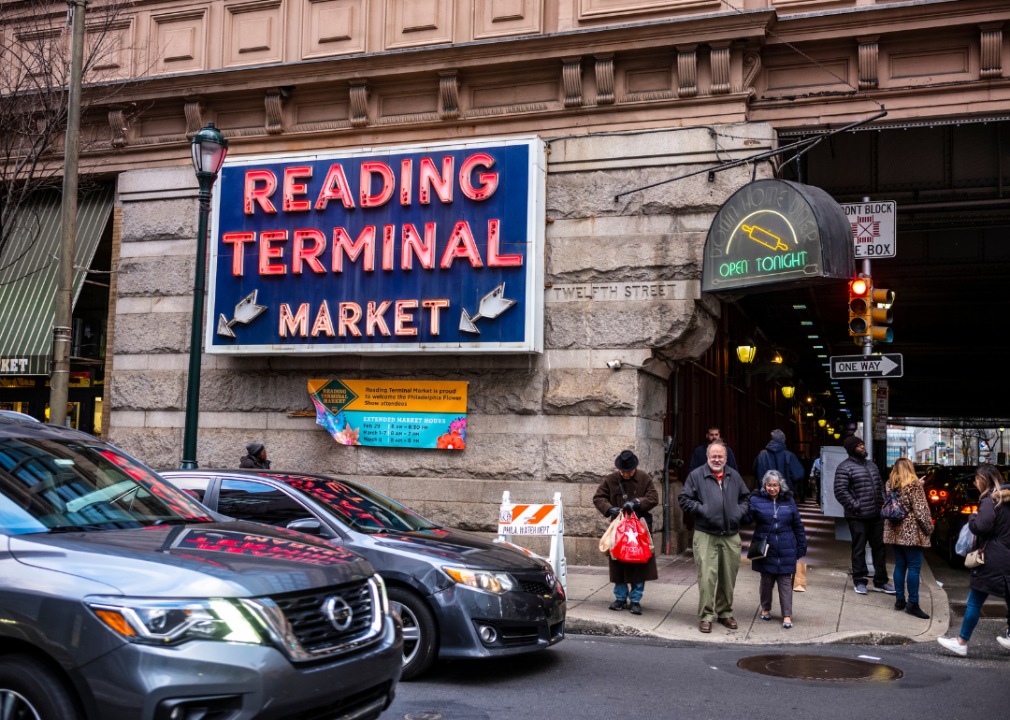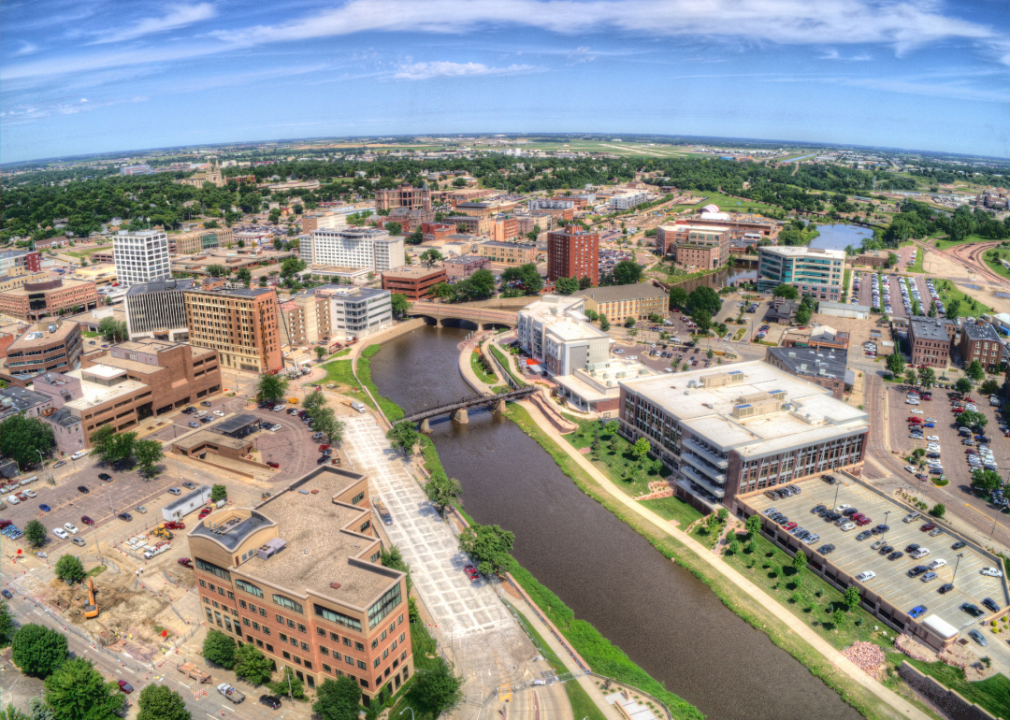Comparing minimum wage to the cost of living in every state

Viktoriia Hnatiuk // Shutterstock
Comparing minimum wage to the cost of living in every state
The federal minimum wage is $7.25 an hour, a rate that has not gone up since 2009. As the current wage stagnates, its purchasing power erodes against inflation. The average living wage today—defined as an income threshold that provides basic shelter and food and keeps a person above the poverty level—is $16.54, according to research from the Massachusetts Institute of Technology.
Of course, what constitutes a living wage depends on the cost of living, which in many cases is dictated by geography. The priciest areas to live in 2020 were the Northeast, Hawaii, Alaska, and the West Coast, reports the Missouri Economic Research and Information Center. The least expensive areas were Southern and Midwestern states.
To compare the cost of living in every state and Washington, D.C. to the minimum wage, Stacker consulted MIT’s Living Wage Calculator. The tool aggregates child care, food, housing, and other living costs into a living wage dependent upon family composition. For the statistics chosen, the calculator assumes that all adults are working full time (2,080 hours a year). Data is recent as of 2020.
The Economic Policy Institute points out that low wages are particularly harmful to workers of color. A $15 minimum wage would represent a pay raise for 31% of African Americans and 26% of Latinos. The Congressional Budget Office estimated in 2019 that a $15 an hour wage would raise the pay rate for 17 million workers—but that it could cost 1.3 million jobs. Major business groups have opposed the move, as have Republicans who have stymied efforts by congressional Democrats to lift the national minimum wage to $15.
As the federal government remains stalled, individual states are moving forward. California was the first state to raise the minimum to $15 an hour (by 2023). In states with their own minimum wage laws, workers have a right to the higher of the two established wages.
Keep reading to see how the minimum wage in your home state compares to the cost of living.
You may also like: Industries with the highest rates of workplace injuries
![]()

Sean Pavone // Shutterstock
Alabama
– Minimum wage: $7.25 ($15,080 annual)
– Living wage for:
— 1 adult: $13.77 ($6.52 difference)
— 1 adult and 1 child: $27.06 ($19.81 difference)
— 2 adults: $11.15 ($3.90 difference)
— 2 adults and 1 child: $14.92 ($7.67 difference)
Like four other states, all in the South, Alabama does not have a minimum wage and therefore adheres to the federal rate of $7.25. Birmingham in 2016 raised the rate to $10.10 an hour, but the state forestalled the increase by passing a law forbidding cities and other local governments from setting higher wages. Birmingham was the first city in the Deep South to try to enact a higher local wage. The cost of living in Alabama is among the lowest in the country.

David Prahl // Shutterstock
Alaska
– Minimum wage: $10.19 ($21,195 annual)
– Living wage for:
— 1 adult: $15.06 ($4.87 difference)
— 1 adult and 1 child: $29.86 ($19.67 difference)
— 2 adults: $11.69 ($1.50 difference)
— 2 adults and 1 child: $16.34 ($6.15 difference)
Alaska’s minimum wage rose to $10.34 on Jan. 1, 2021, although school bus drivers in the state must be paid at least twice that. Consumer prices spiked 3% in 2018, the first time in three years that the state’s costs increased more rapidly than the country’s, according to labor statistics from the Alaska state government. One of the drivers was the increased price of medical care. Inflation was low in 2019 and then prices plunged in 2020 during the coronavirus pandemic, for the largest deflation in the Consumer Price Index since 1960.

Charles Lewis // Shutterstock
Arizona
– Minimum wage: $12.00 ($24,960 annual)
– Living wage for:
— 1 adult: $14.94 ($2.94 difference)
— 1 adult and 1 child: $29.01 ($17.01 difference)
— 2 adults: $12.15 ($0.15 difference)
— 2 adults and 1 child: $15.99 ($3.99 difference)
Arizona’s minimum wage rose to $12.15 an hour in January 2021, an increase voters approved in 2016 based on rises in the cost of living. Flagstaff set its own minimum wage to $15 an hour. It will rise further to $15.50 by 2022, and beginning the next year, will be determined by the inflation rate or be set at $2 above the state’s minimum wage, whichever is higher. Tucson and Mesa, Arizona, were ranked among the 10 U.S. cities with the lowest cost of living in 2020.

Eduardo Medrano // Shutterstock
Arkansas
– Minimum wage: $10.00 ($20,800 annual)
– Living wage for:
— 1 adult: $13.29 ($3.29 difference)
— 1 adult and 1 child: $28.23 ($18.23 difference)
— 2 adults: $11.25 ($1.25 difference)
— 2 adults and 1 child: $15.54 ($5.54 difference)
Arkansas is among 25 states that scheduled a 2021 increase in the minimum wage, with the state’s minimum wage rising to $11 an hour on Jan. 1, 2021, as approved by voters in 2018. Workers who rely on tips must be paid at least $2.63 an hour and an employer must make up the difference if their wage falls short of $11 an hour. Lawmakers debated exempting small businesses and nonprofit organizations, but the legislation was not approved.

Sean Pavone // Shutterstock
California
– Minimum wage: $12.00 ($24,960 annual)
– Living wage for:
— 1 adult: $18.66 ($6.66 difference)
— 1 adult and 1 child: $40.34 ($28.34 difference)
— 2 adults: $15.13 ($3.13 difference)
— 2 adults and 1 child: $21.76 ($9.76 difference)
California’s minimum wage is now $14 an hour, $13 an hour for companies with fewer than 25 employees, and will rise through 2023 to $15 an hour. After that it is to be adjusted annually. In addition, cities in California can set their own wage regulations. In Los Angeles, the minimum wage has been set at $15 an hour since 2020. One reason for the high cost of living in California is housing prices: For a typical family, rent accounts for at least 30% of income in more than two-thirds of the state’s zip codes.
You may also like: 50 ways the workforce has changed in 50 years

Jacob L. // Shutterstock
Colorado
– Minimum wage: $12.00 ($24,960 annual)
– Living wage for:
— 1 adult: $16.35 ($4.35 difference)
— 1 adult and 1 child: $34.31 ($22.31 difference)
— 2 adults: $12.91 ($0.91 difference)
— 2 adults and 1 child: $18.65 ($6.65 difference)
Colorado raised its minimum wage to $12.32 in January. An amendment to the state’s constitution in 2017 upped the rate to $9.30 an hour, with annual increases of 90 cents until it reached $12. Now it is adjusted each year for cost-of-living increases. Higher prices for energy and other items except for food drove up the cost of living in the Denver area at the beginning of 2021, according to the federal Bureau of Labor Statistics.

Dragana Gordic // Shutterstock
Connecticut
– Minimum wage: $12.00 ($24,960 annual)
– Living wage for:
— 1 adult: $15.98 ($3.98 difference)
— 1 adult and 1 child: $33.11 ($21.11 difference)
— 2 adults: $12.75 ($0.75 difference)
— 2 adults and 1 child: $17.98 ($5.98 difference)
Connecticut’s minimum hourly wage is rising gradually over the next several years, climbing to $14 in 2022 and $15 in 2023. Connecticut Voices for Children, a think tank based in the state, warns that families relying on those jobs will lose more than half of the increases because they will potentially lose benefits from the state. It is urging the legislators to expand Medicaid and take other steps to help poor families.

Felix Mizioznikov // Shutterstock
Delaware
– Minimum wage: $9.25 ($19,240 annual)
– Living wage for:
— 1 adult: $15.32 ($6.07 difference)
— 1 adult and 1 child: $32.17 ($22.92 difference)
— 2 adults: $12.33 ($3.08 difference)
— 2 adults and 1 child: $17.5 ($8.25 difference)
Housing can be expensive in Delaware, with both home values and rental costs higher than the national median. The state’s minimum wage has been $9.25 since 2019, but will increase to $10.50 on Jan. 1, 2022. In 2024, it is set to rise to $13.25 and in 2025 it will reach $15.

Orhan Cam // Shutterstock
Washington DC
– Minimum wage: $13.25 ($27,560 annual)
– Living wage for:
— 1 adult: $20.12 ($6.87 difference)
— 1 adult and 1 child: $38.48 ($25.23 difference)
— 2 adults: $14.88 ($1.63 difference)
— 2 adults and 1 child: $20.69 ($7.44 difference)
The Consumer Price Index in the area increased 0.7% at the beginning of 2021, according to the U.S. Bureau of Labor Statistics. Driving the rise was an increase in energy costs, both for heating and for gasoline. Food costs fell. The District of Columbia’s minimum wage, currently $15 an hour, rises to $15.20 in July 2021.

Kamira // Shutterstock
Florida
– Minimum wage: $8.56 ($17,805 annual)
– Living wage for:
— 1 adult: $14.82 ($6.26 difference)
— 1 adult and 1 child: $30.92 ($22.36 difference)
— 2 adults: $11.99 ($3.43 difference)
— 2 adults and 1 child: $16.77 ($8.21 difference)
Florida’s voters in 2020 approved raising the minimum wage each year until it reaches $15 an hour in 2026. Then it will rise with inflation. Business groups warned the increases would destroy the state’s economy, but more than 60% of voters approved the change. At the time Florida was the eighth state in the country to plan for an increase to $15 an hour. The state’s average income is 87.4% of the national average.
You may also like: 50 most physical jobs in America

Tero Vesalainen // Shutterstock
Georgia
– Minimum wage: $7.25 ($15,080 annual)
– Living wage for:
— 1 adult: $15.36 ($8.11 difference)
— 1 adult and 1 child: $29.63 ($22.38 difference)
— 2 adults: $12.06 ($4.81 difference)
— 2 adults and 1 child: $16.22 ($8.97 difference)
Georgia’s minimum wage is only $5.15 an hour, so with few exceptions, the federal rate applies. A history professor at the University of Georgia, James Cobb, told Atlanta’s public radio station WABE in 2019 that the low rate showed that the state prioritized businesses over workers. The president of the conservative Georgia Public Policy Foundation disagreed, and said that it enabled companies to hire more workers. Georgia had the eighth-lowest cost of living in the country in 2020, according to the Missouri Economic Research and Information Center.

cleanfotos // Shutterstock
Hawaii
– Minimum wage: $10.10 ($21,008 annual)
– Living wage for:
— 1 adult: $19.43 ($9.33 difference)
— 1 adult and 1 child: $38.57 ($28.47 difference)
— 2 adults: $15.06 ($4.96 difference)
— 2 adults and 1 child: $20.85 ($10.75 difference)
Hawaii’s minimum wage could go up to $12 an hour in 2022. The state had the highest cost of living in the country in 2020. What makes it so expensive? The biggest reason was the cost of housing, which is about three times that of the rest of the United States. The island lifestyle comes at a price.

Charles Knowles // Shutterstock
Idaho
– Minimum wage: $7.25 ($15,080 annual)
– Living wage for:
— 1 adult: $13.95 ($6.70 difference)
— 1 adult and 1 child: $27.94 ($20.69 difference)
— 2 adults: $11.67 ($4.42 difference)
— 2 adults and 1 child: $15.52 ($8.27 difference)
Idaho is one of 13 states with the same minimum wage as the federal government. A Democratic lawmaker from Boise, state Sen. Grant Burgoyne, proposed raising the rate to $15 an hour by July 2023, arguing that many residents are struggling financially. Others counter that small businesses would be harmed by the increase. A move to get an initiative to raise the rate on the November ballot in 2020 was suspended because of the coronavirus pandemic. Idaho had the 19th-lowest cost of living in 2020.

AevanStock // Shutterstock
Illinois
– Minimum wage: $10.00 ($20,800 annual)
– Living wage for:
— 1 adult: $15.37 ($5.37 difference)
— 1 adult and 1 child: $31.16 ($21.16 difference)
— 2 adults: $12.29 ($2.29 difference)
— 2 adults and 1 child: $16.98 ($6.98 difference)
Illinois’ minimum wage will rise gradually to reach $15 in 2025. Gov. J.B. Pritzker signed legislation dictating the increases in 2019. Before the 2020 increase, the state had gone a decade without raising its rate.

Sean Pavone // Shutterstock
Indiana
– Minimum wage: $7.25 ($15,080 annual)
– Living wage for:
— 1 adult: $13.44 ($6.19 difference)
— 1 adult and 1 child: $27.23 ($19.98 difference)
— 2 adults: $11.08 ($3.83 difference)
— 2 adults and 1 child: $14.99 ($7.74 difference)
Indiana has the same minimum wage as the federal government. It is in the top 10 states for the lowest cost of living. A Democratic senator from Gary, Sen. Eddie Melton, wants to raise the state’s rate to $10 an hour. It has not changed since 2009, while the cost of living has risen 20% in that time.
You may also like: 50 college majors that earn the least money

Rawpixel.com // Shutterstock
Iowa
– Minimum wage: $7.25 ($15,080 annual)
– Living wage for:
— 1 adult: $13.62 ($6.37 difference)
— 1 adult and 1 child: $29.18 ($21.93 difference)
— 2 adults: $11.57 ($4.32 difference)
— 2 adults and 1 child: $16.04 ($8.79 difference)
Iowa’s minimum wage also matches the federal government’s. In 2017, the state’s legislature blocked minimum rate hikes in five Iowa counties. The law prevents cities or counties from passing minimum wages that are higher than the state. Iowa’s cost of living was the 12th lowest in the country in 2020.

Andriy Blokhin // Shutterstock
Kansas
– Minimum wage: $7.25 ($15,080 annual)
– Living wage for:
— 1 adult: $13.51 ($6.26 difference)
— 1 adult and 1 child: $28.39 ($21.14 difference)
— 2 adults: $11.27 ($4.02 difference)
— 2 adults and 1 child: $15.59 ($8.34 difference)
Kansas also has the same minimum wage as the federal government and its cost of living in 2020 was almost the lowest in the country. It was second only to Mississippi. At the beginning of 2021, a group of Democrats proposed more than doubling the rate over six years, to $15 an hour. The state government in Kansas is controlled by Republicans.

Halfpoint // Shutterstock
Kentucky
– Minimum wage: $7.25 ($15,080 annual)
– Living wage for:
— 1 adult: $13.48 ($6.23 difference)
— 1 adult and 1 child: $28.25 ($21.00 difference)
— 2 adults: $11.09 ($3.84 difference)
— 2 adults and 1 child: $15.53 ($8.28 difference)
Kentucky’s minimum wage has remained unchanged for more than a decade. One Democratic state legislator, Sen. Reggie Thomas of Lexington, has proposed raising it to $15 an hour by 2026. As for the cost of living, it ranked the 18th lowest in the country in 2020.

Adam Melnyk // Shutterstock
Louisiana
– Minimum wage: $7.25 ($15,080 annual)
– Living wage for:
— 1 adult: $14.06 ($6.81 difference)
— 1 adult and 1 child: $29.61 ($22.36 difference)
— 2 adults: $11.64 ($4.39 difference)
— 2 adults and 1 child: $16.21 ($8.96 difference)
Louisiana is one of five states with no minimum wage and the federal rate therefore applies. The state has the second-highest percentage of workers in the country paid the minimum wage. Louisiana had the 17th lowest cost of living in the country in 2020. Louisiana Gov. John Bel Edwards wants an increase in that amount and called $7.25 insufficient. He expects local officials to push for an increase, as well.

Kenneth Sponsler // Shutterstock
Maine
– Minimum wage: $12.00 ($24,960 annual)
– Living wage for:
— 1 adult: $14.92 ($2.92 difference)
— 1 adult and 1 child: $30.63 ($18.63 difference)
— 2 adults: $11.94
— 2 adults and 1 child: $16.79 ($4.79 difference)
Maine had the 13th highest cost of living in 2020. The state’s minimum wage rose to $12.15 an hour at the beginning of 2021, and now requires yearly adjustments to the minimum wage based on the cost of living. In each of the past three years, the minimum wage rose $1.
You may also like: Fastest-growing occupations that earn over $75,000 per year

eurobanks // Shutterstock
Maryland
– Minimum wage: $11.00 ($22,880 annual)
– Living wage for:
— 1 adult: $17.25 ($6.25 difference)
— 1 adult and 1 child: $34.74 ($23.74 difference)
— 2 adults: $13.33 ($2.33 difference)
— 2 adults and 1 child: $18.75 ($7.75 difference)
As of 2021, Maryland’s minimum wage stands at $11.75 an hour and will increase to $15 by 2025. In 2019, lawmakers overrode a veto by Gov. Larry Hogan to authorize the raise. Maryland was the sixth state to vote to phase in a $15 minimum wage. About 573,000 workers in Maryland earn less than that, according to the National Employment Law Project, or about 22% of the workforce.

Travellaggio // Shutterstock
Massachusetts
– Minimum wage: $12.75 ($26,520 annual)
– Living wage for:
— 1 adult: $17.74 ($4.99 difference)
— 1 adult and 1 child: $36.88 ($24.13 difference)
— 2 adults: $13.12 ($0.37 difference)
— 2 adults and 1 child: $19.78 ($7.03 difference)
Massachusetts’ minimum wage is $13.50 an hour as of January 2021 and will rise again to $14.25 in 2022 and $15 in 2023. The state’s legislature passed the $15 rate in 2018 as part of a bill that also established a paid family and medical leave policy. A CNBC study in 2018 found the state was the third most expensive place to live in the U.S., with the median price for a home in the Boston area 70% higher than the country as a whole.

Romrodphoto // Shutterstock
Michigan
– Minimum wage: $9.65 ($20,072 annual)
– Living wage for:
— 1 adult: $13.63 ($3.98 difference)
— 1 adult and 1 child: $31.15 ($21.50 difference)
— 2 adults: $11.1 ($1.45 difference)
— 2 adults and 1 child: $16.96 ($7.31 difference)
Gov. Gretchen Whitmer proposed helping to pay Michigan workers $15 an hour with $300 million in federal money. The state would create grants for businesses to cover the difference between their workers’ salary and $15 an hour. Michigan had expected to raise its rate in 2021, but state law prohibited the increase because the unemployment rate was above 8.5%.

James Kirkikis // Shutterstock
Minnesota
– Minimum wage: $10.00 ($20,800 annual)
– Living wage for:
— 1 adult: $14.9 ($4.90 difference)
— 1 adult and 1 child: $31.33 ($21.33 difference)
— 2 adults: $12.32 ($2.32 difference)
— 2 adults and 1 child: $17.1 ($7.10 difference)
The cost of living in Minnesota is about average in Minnesota, where the minimum wage increased to $10.08 in January 2021 and will rise again to $14.25 in July 2021 and $15 in 2022. After that, the increase will be linked to inflation. Rates are lower for small businesses with 100 or fewer employees.

Viktoriia Hnatiuk // Shutterstock
Mississippi
– Minimum wage: $7.25 ($15,080 annual)
– Living wage for:
— 1 adult: $13.43 ($6.18 difference)
— 1 adult and 1 child: $26.74 ($19.49 difference)
— 2 adults: $11.28 ($4.03 difference)
— 2 adults and 1 child: $14.75 ($7.50 difference)
Mississippi, like its neighbors, does not have a minimum wage and so the federal rate is in effect in the state. It had the lowest cost of living in the country in 2020. Some lawmakers in the state are calling for a minimum wage law that would raise the rate to $15 over four years. Gov. Tate Reeves announced in May 2021 that the state would discontinue the supplemental federal unemployment benefits available because of the coronavirus pandemic.
You may also like: Highest-Paid Jobs in Health Care

Sean Pavone // Shutterstock
Missouri
– Minimum wage: $9.45 ($19,656 annual)
– Living wage for:
— 1 adult: $13.72 ($4.27 difference)
— 1 adult and 1 child: $28.65 ($19.20 difference)
— 2 adults: $11.48 ($2.03 difference)
— 2 adults and 1 child: $15.74 ($6.29 difference)
Missouri’s minimum wage increased to $10.30 an hour in 2021 and will ultimately reach $12 an hour in 2023, still falling short of the current requirements for a living wage in the state. The raises are among a series of increases over five years that voters approved overwhelmingly in 2018.

Beeldtype // Shutterstock
Montana
– Minimum wage: $8.65 ($17,992 annual)
– Living wage for:
— 1 adult: $13.94 ($5.29 difference)
— 1 adult and 1 child: $29.63 ($20.98 difference)
— 2 adults: $11.53 ($2.88 difference)
— 2 adults and 1 child: $16.35 ($7.70 difference)
Montana’s minimum wage rose to $8.75 an hour in January 2021. It is adjusted annually for inflation, a protection that voters approved as a ballot initiative in 2006. Up to 10,000 workers in the state were paid less than $8.75 in 2020 and are expected to get raises as a result of the increase. The food and hotel industry had the largest number of minimum wage workers in 2019.

Maria Sbytova // Shutterstock
Nebraska
– Minimum wage: $9.00 ($18,720 annual)
– Living wage for:
— 1 adult: $13.57 ($4.57 difference)
— 1 adult and 1 child: $29.31 ($20.31 difference)
— 2 adults: $11.65 ($2.65 difference)
— 2 adults and 1 child: $16.08 ($7.08 difference)
An Omaha lawmaker in 2021 proposed raising the minimum wage to $20 an hour, increasing the rate $1 a year until 2032. Sen. Terry McKinney said the higher pay was needed to keep workers in the state. Opponents said businesses could not afford the hike.

Miune // Shutterstock
Nevada
– Minimum wage: $8.00 ($16,640 annual)
– Living wage for:
— 1 adult: $13.67 ($5.67 difference)
— 1 adult and 1 child: $28.98 ($20.98 difference)
— 2 adults: $11.48 ($3.48 difference)
— 2 adults and 1 child: $15.91 ($7.91 difference)
Nevada will raise its minimum wage by 75 cents a year through 2024, reaching $9.75 in 2021. The state has a two-tier system, however: If employees receive health benefits, the minimum wage is lower.

Kite_rin
New Hampshire
– Minimum wage: $7.25 ($15,080 annual)
– Living wage for:
— 1 adult: $14.47 ($7.22 difference)
— 1 adult and 1 child: $30.07 ($22.82 difference)
— 2 adults: $11.45 ($4.20 difference)
— 2 adults and 1 child: $16.37 ($9.12 difference)
New Hampshire is unusual among New England states in that its minimum wage is set at the federal one. Its neighbors all have rates that are $11.50 an hour, with Massachusetts the highest. The New Hampshire Fiscal Policy Institute notes that the state workers making the minimum wage fall below the federal poverty guidelines except for a single person.
You may also like: Most common jobs in America 100 years ago

FotosForTheFuture // Shutterstock
New Jersey
– Minimum wage: $11.00 ($22,880 annual)
– Living wage for:
— 1 adult: $16.2 ($5.20 difference)
— 1 adult and 1 child: $35.93 ($24.93 difference)
— 2 adults: $13.19 ($2.19 difference)
— 2 adults and 1 child: $19.6 ($8.60 difference)
A law that New Jersey Gov. Phil Murphy signed in 2019 raises the minimum wage gradually to $15 an hour in 2024. It reached $12 per hour on Jan. 1, 2021. Small and seasonal businesses and agricultural employers have more time to meet the rates.

wee dezign // Shutterstock
New Mexico
– Minimum wage: $9.00 ($18,720 annual)
– Living wage for:
— 1 adult: $13.97 ($4.97 difference)
— 1 adult and 1 child: $28.65 ($19.65 difference)
— 2 adults: $11.66 ($2.66 difference)
— 2 adults and 1 child: $15.82 ($6.82 difference)
New Mexico’s minimum wage increased to $10.50 an hour on Jan. 1, 2021, and will rise again to $11.50 in 2022 and to $12.00 an hour in 2023. Cities and counties may have their own rates. Santa Fe, for example, has set its rate at $12.10 an hour. New Mexico had the seventh-lowest cost of living in 2020.

Ryan DeBerardinis // Shutterstock
New York
– Minimum wage: $11.80 ($24,544 annual)
– Living wage for:
— 1 adult: $18.62 ($6.82 difference)
— 1 adult and 1 child: $36 ($24.20 difference)
— 2 adults: $13.73 ($1.93 difference)
— 2 adults and 1 child: $19.5 ($7.70 difference)
In New York, the minimum wage was $12.50 an hour for most of the state as of Dec. 31, 2020. But in New York City, it had been $15 since the end of 2019; in its suburbs of Westchester County and Long Island, it was $14. Fast-food workers have a separate pay scale: $15 in New York City and $14.50 in the rest of the state, to rise to $15 by July 1, 2021. New York comes in third in the ranking of the highest cost of living in 2020 and New York City’s Manhattan borough topped the list of most expensive urban areas in 2021.

Kevin Ruck // Shutterstock
North Carolina
– Minimum wage: $7.25 ($15,080 annual)
– Living wage for:
— 1 adult: $14.72 ($7.47 difference)
— 1 adult and 1 child: $30.09 ($22.84 difference)
— 2 adults: $11.66 ($4.41 difference)
— 2 adults and 1 child: $16.45 ($9.20 difference)
Legislation reintroduced in 2021 would increase North Carolina’s minimum wage to $15 an hour by 2023 and index it to the cost of living. The bill, if passed, would also discontinue the below-minimum wage for persons with disabilities and workers who receive tips, and do away with exemptions for agricultural workers and domestic workers.

Syda Productions // Shutterstock
North Dakota
– Minimum wage: $7.25 ($15,080 annual)
– Living wage for:
— 1 adult: $13.08 ($5.83 difference)
— 1 adult and 1 child: $27.73 ($20.48 difference)
— 2 adults: $10.86 ($3.61 difference)
— 2 adults and 1 child: $15.22 ($7.97 difference)
North Dakota’s minimum wage matches the federal rate, which makes the state an outlier from its neighbors. South Dakota, Montana, and Minnesota have enacted minimum wages that are higher than the federal one, and they are adjusted annually. An attempt to raise the rate to $15 an hour by 2027 died in the legislature in early 2021.
You may also like: Best jobs that require a bachelor’s degree

aceshot1 // Shutterstock
Ohio
– Minimum wage: $8.70 ($18,096 annual)
– Living wage for:
— 1 adult: $13.16 ($4.46 difference)
— 1 adult and 1 child: $28.58 ($19.88 difference)
— 2 adults: $10.94 ($2.24 difference)
— 2 adults and 1 child: $15.66 ($6.96 difference)
Some Ohio legislators are trying to raise the minimum wage gradually to $15 an hour by 2027. Afterward, it would keep pace with inflation as the Ohio constitution demands. They argue it would improve productivity and spur spending.

gpointstudio // Shutterstock
Oklahoma
– Minimum wage: $7.25 ($15,080 annual)
– Living wage for:
— 1 adult: $13.53 ($6.28 difference)
— 1 adult and 1 child: $28.23 ($20.98 difference)
— 2 adults: $11.25 ($4.00 difference)
— 2 adults and 1 child: $15.5 ($8.25 difference)
The last time Oklahoma’s state minimum rate was increased was in 2008. In Oklahoma City, the state’s largest city, the cost of housing is about 20% below the national average, according to a ranking by Kiplinger. As in other states, a lawmaker is trying to raise the minimum rate, in this case to $10.50 an hour.

Josemaria Toscano // Shutterstock
Oregon
– Minimum wage: $12.00 ($24,960 annual)
– Living wage for:
— 1 adult: $16.85 ($4.85 difference)
— 1 adult and 1 child: $33.07 ($21.07 difference)
— 2 adults: $13.26 ($1.26 difference)
— 2 adults and 1 child: $18.11 ($6.11 difference)
Oregon’s minimum wage is to rise every year until it reaches $13.50 in 2022. After that, it will be adjusted annually based on the Consumer Price Index. The rate varies depending on location but is generally higher in urban areas.

JWCohen // Shutterstock
Pennsylvania
– Minimum wage: $7.25 ($15,080 annual)
– Living wage for:
— 1 adult: $13.39 ($6.14 difference)
— 1 adult and 1 child: $27.57 ($20.32 difference)
— 2 adults: $10.77 ($3.52 difference)
— 2 adults and 1 child: $15.12 ($7.87 difference)
Gov. Tom Wolf, a Democrat, is calling for an increase to $12 an hour on July 1, 2021, followed by annual increases of 50 cents until the rate reaches $15 per hour in 2027. The incomes of more than 1.1 million residents of the state would rise. A poll from Franklin & Marshall College in March 2021 found support for $12 an hour among 67% of voters.

Tyler Olson // Shutterstock
Rhode Island
– Minimum wage: $10.50 ($21,840 annual)
– Living wage for:
— 1 adult: $14.79 ($4.29 difference)
— 1 adult and 1 child: $30.63 ($20.13 difference)
— 2 adults: $11.7 ($1.20 difference)
— 2 adults and 1 child: $16.73 ($6.23 difference)
Rhode Island’s minimum wage is rising to $15 an hour over the next four years under legislation signed by Gov. Dan McKee in May 2021. He said the state estimated the increase would raise wages for about 70,000 workers by 2022, and for about 140,000 workers by 2025. Lawmakers said the minimum wage has not kept up with inflation.
You may also like: Jobs that might not exist in 50 years

sirtravelalot // Shutterstock
South Carolina
– Minimum wage: $7.25 ($15,080 annual)
– Living wage for:
— 1 adult: $14.58 ($7.33 difference)
— 1 adult and 1 child: $29.81 ($22.56 difference)
— 2 adults: $12.07 ($4.82 difference)
— 2 adults and 1 child: $16.33 ($9.08 difference)
South Carolina has no minimum wage of its own. Sen. Katrina Shealy, a Republican lawmaker from Lexington, wants to end an exemption that enables employers to pay workers with disabilities less than the minimum wage. Some advocates oppose the proposal, saying not all of the employees can work competitively but enjoy their jobs.

Jacob Boomsma // Shutterstock
South Dakota
– Minimum wage: $9.30 ($19,344 annual)
– Living wage for:
— 1 adult: $12.61 ($3.31 difference)
— 1 adult and 1 child: $27.06 ($17.76 difference)
— 2 adults: $10.65 ($1.35 difference)
— 2 adults and 1 child: $14.84 ($5.54 difference)
South Dakota’s minimum wage rose slightly in 2021 to $9.45 an hour, while tipped employees—eligible for half the rate—saw their minimum wage rates rise to $4.72 an hour. The rate is linked to the cost of living as measured by the federal Department of Labor’s Consumer Price Index.

f11photo // Shutterstock
Tennessee
– Minimum wage: $7.25 ($15,080 annual)
– Living wage for:
— 1 adult: $13.25 ($6.00 difference)
— 1 adult and 1 child: $26.3 ($19.05 difference)
— 2 adults: $10.72 ($3.47 difference)
— 2 adults and 1 child: $14.45 ($7.20 difference)
Some Tennessee lawmakers want to create a state minimum wage—the state currently uses the federal rate. A proposal submitted in March would increase the rate to $12 an hour by 2025. A bill introduced at the beginning of 2020 would have upped it to $15 an hour.

Roschetzky Photography // Shutterstock
Texas
– Minimum wage: $7.25 ($15,080 annual)
– Living wage for:
— 1 adult: $14.01 ($6.76 difference)
— 1 adult and 1 child: $28.68 ($21.43 difference)
— 2 adults: $11.32 ($4.07 difference)
— 2 adults and 1 child: $15.64 ($8.39 difference)
Texas’ minimum wage is at the federal level. Democrats have tried to raise it, but Republicans dominating the legislature have blocked those efforts. If the minimum wage was raised to $15 an hour, the wages of some 4.5 million Texans could increase, according to the Economic Policy Institute. Opponents argue businesses would be hurt. Seven Texas cities made Kiplinger’s 2020 list of the 25 cheapest U.S. cities to live in, with McAllen securing the top spot.

WAYHOME studio // Shutterstock
Utah
– Minimum wage: $7.25 ($15,080 annual)
– Living wage for:
— 1 adult: $14.52 ($7.27 difference)
— 1 adult and 1 child: $29.56 ($22.31 difference)
— 2 adults: $11.99 ($4.74 difference)
— 2 adults and 1 child: $16.28 ($9.03 difference)
More than 48% of Utah residents have jobs that pay less than $15 an hour, while 35.4% make less than $12 an hour. Two lawmakers have introduced bills to increase the minimum wage in stages until reaching $15 an hour by 2026, and peg the rate to urban or rural areas.
You may also like: Jobs Most in Danger of Being Automated

Matej Kastelic // Shutterstock
Vermont
– Minimum wage: $10.96 ($22,797 annual)
– Living wage for:
— 1 adult: $14.93 ($3.97 difference)
— 1 adult and 1 child: $31.77 ($20.81 difference)
— 2 adults: $12.18 ($1.22 difference)
— 2 adults and 1 child: $17.34 ($6.38 difference)
Vermont’s minimum wage rose 79 cents in 2021, to $11.75. The Vermont Legislature voted to increase the minimum wage in the state by $1.59 over the two years. In 2022, it will switch back to being pegged to the Consumer Price Index. As for cost of living, Vermont Public Radio found that in 2018, residents spent more on groceries than any other state, according to the U.S. Bureau of Economic Analysis. But on taxes, Vermont is below the U.S. average for middle- and low-income people.

Volodymyr Goinyk // Shutterstock
Virginia
– Minimum wage: $7.25 ($15,080 annual)
– Living wage for:
— 1 adult: $16.61 ($9.36 difference)
— 1 adult and 1 child: $32.8 ($25.55 difference)
— 2 adults: $12.57 ($5.32 difference)
— 2 adults and 1 child: $17.78 ($10.53 difference)
Virginia’s minimum wage rose to $9.50 an hour in May 2021, the first of three increases that will culminate at $12 an hour in 2023. The increase became possible after Democrats gained the majority in the state legislature. Some businesses worried that the increases will force them to lay off workers. Republicans opposed the move.

Nadia Yong // Shutterstock
Washington
– Minimum wage: $13.50 ($28,080 annual)
– Living wage for:
— 1 adult: $16.34 ($2.84 difference)
— 1 adult and 1 child: $31.95 ($18.45 difference)
— 2 adults: $12.33
— 2 adults and 1 child: $17.39 ($3.89 difference)
Washington’s minimum wage increased slightly in 2021 to $13.69 an hour, although Seattle’s is higher at $16.69 an hour. Washington voters approved raising the minimum rate to $13.50 in 2020. After that, adjustments are based on the Consumer Price Index. A trial has begun to determine whether detainees who work at a for-profit immigration detention center in Washington state must be paid minimum wage.

Joseph Sohm // Shutterstock
West Virginia
– Minimum wage: $8.75 ($18,200 annual)
– Living wage for:
— 1 adult: $13.38 ($4.63 difference)
— 1 adult and 1 child: $28.2 ($19.45 difference)
— 2 adults: $11.17 ($2.42 difference)
— 2 adults and 1 child: $15.6 ($6.85 difference)
West Virginia’s small business owners are worried about a $15-an-hour federal minimum wage, unconvinced that they could raise prices enough to cover the difference. The state has one of the highest poverty rates in the country, at 16%, and low wages. Half of all workers in West Virginia make less than $15 an hour. West Virginia Sen. Joe Manchin, a Democrat, has come out against the increase.

Alena Mozhjer // Shutterstock
Wisconsin
– Minimum wage: $7.25 ($15,080 annual)
– Living wage for:
— 1 adult: $14.02 ($6.77 difference)
— 1 adult and 1 child: $30.17 ($22.92 difference)
— 2 adults: $11.49 ($4.24 difference)
— 2 adults and 1 child: $16.51 ($9.26 difference)
Wisconsin’s minimum wage is at the federal level, unlike its neighbors Michigan, Wisconsin, and Illinois. Iowa, however, has stayed at the same rate. As in other states, a higher rate is under discussion. An economics professor at the University of Wisconsin-Madison, Tim Smeeding, told Wisconsin Public Radio that a federal rate of $15 an hour would be too high all at once. He advocates raising it in stages.

Prostock-studio // Shutterstock
Wyoming
– Minimum wage: $7.25 ($15,080 annual)
– Living wage for:
— 1 adult: $13.19 ($5.94 difference)
— 1 adult and 1 child: $27.53 ($20.28 difference)
— 2 adults: $10.83 ($3.58 difference)
— 2 adults and 1 child: $15.18 ($7.93 difference)
Wyoming’s minimum wage is $5.15 an hour and so the higher federal rate prevails. A lawmaker in March 2021 proposed raising the rate to $15 an hour. The Casper Star-Tribune noted that Wyoming’s low minimum tied with Georgia’s, but also that in 2019 lawmakers shot down an attempt to raise the rate to $8.50.
You may also like: 50 jobs that no longer exist